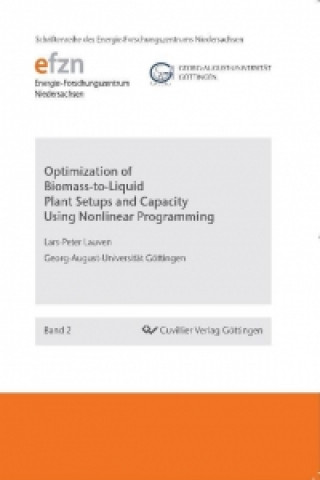
Livrare
Consilier de cumpărături





Nu se pretează? Nu contează! La noi puteți returna bunurile în 30 de zile
 Voucher cadou
orice valoare
Voucher cadou
orice valoare
Cu un voucher cadou nu veți da greș. În schimbul voucherului, destinatarul își poate alege orice din oferta noastră.
Optimization of Biomass-to-Liquid Plant Setups and Capacity Using Nonlinear Programming
 engleză
engleză
 75 b
75 b
30 de zile pentru retur bunuri
Ar putea de asemenea, să te intereseze


Potentially rising oil prices caused by an increasing relative scarcity of mineral oil have farreachingconsequences for the transportation sector, the chemical industry and mineral oilcompanies in particular. As national laws in Germany require biofuels to be mixed intoconventional fuel to an increasing extend (BioKraftQuG 2009), mineral oil companies need toidentify economically competitive as well as technically feasible biofuel production processesto meet these requirements. A first generation of biofuels was introduced on a large scale buthas been criticized for competing with the agricultural production of food and for yieldingrelatively modest quantities of fuel per hectare of agricultural land. For this reason, 2ndgeneration biofuel production pathways such as Biomass-to-Liquid (BtL), which convertlignocellulosic material into liquid hydrocarbons using Fischer-Tropsch synthesis, have beendeveloped. While 2nd generation biofuels are superior to their 1st generation counterpartsfrom a yield-per-hectare-perspective and cause less competition for agricultural soils, asignificant disadvantage is the considerable investment required for the construction ofBiomass-to-Liquid plants. The corresponding investment-related costs affect thecompetitiveness of 2nd generation biofuels negatively, leaving it in doubt whether BtL fuelscould become an economically viable option. A frequently discussed way to improve specificinvestment-related costs is to increase plant sizes to improve economies of scale. While thisimprovement has been realized in several conventional kinds of plants like mineral oilrefineries, power plants and Coal-to-Liquid plants, the application on BtL plants iscomplicated by the fact that larger plants are associated with higher specific biomasstransportation costs. This is because a higher biomass input requires biomass to betransported over larger distances. The unresolved antagonism between economies of scaleand specific biomass transportation costs has so far hindered the realization of BtL plants.The aim of this thesis is to develop a methodology to determine optimal BtL plant sizes bytaking nonlinear factors into account. The methodology is required to determine acompromise between minimizing investment-related costs by applying economies of scaleand minimizing specific biomass transportation costs by keeping the required transportationdistances short. The optimal plant size is however influenced by a third influencing factor.Whether it is advantageous to transport biomass over a certain distance also depends on thevalue of a plant's products. Biomass-to-Liquid plants can have a variety of productcompositions depending on the catalyst and reaction temperature used in the biofuelsynthesis reaction. Depending on which substances are produced and which are upgradedfor sale, converted into fuels or combusted for electricity generation, both the value of theproducts and the required investment may differ considerably. While a number of processes,including biomass treatment and gasification, as well as the Fischer-Tropsch synthesis itself,are required for all considered plant setup alternatives, the choice of upgrading equipmentmay result in very dissimilar plant setups. By making the capacities of the individualupgrading processes the variables of the optimization model, economies of scale, specificbiomass transportation costs and the products' value are considered simultaneously for thefirst time.The thesis primarily focuses on the implementation of an optimization model and itsapplication on a variety of scenarios. These scenarios are intended to represent differentplant setups and logistics concepts. In order to assess the scale of differences in profitability,the essential influencing factors determining the profitability of BtL plants were included intothe model calculations. As the problem at hand is neither linear nor quadratic, it cannot besolved reliably using established solvers for these two classes of problems. Instead, severalsolvers designed to handle non-quadratic nonlinear multidimensional problems were appliedto find the most suitable way to approach the solution of the problem.The objective function has been designed to maximize the annual profit resulting from plantconstruction and operation. Maximizing this annual profit is subject to a number of primarilytechnical constraints. These result from the mass balances of the plant, its electricity demandand the specific requirements of individual processes. In addition to securing the validity ofthe mass balances, these constraints also ensure that the entire Fischer-Tropsch productstream undergoes some kind of upgrading, separation or combustion treatment. The sum ofall processes producing salable products is used to approximate the required capacity of theplant as a whole. The total plant capacity then serves to calculate the investment required forthe other plant processes and the costs for the purchase and transportation of the requiredinput biomass.Biomass transportation distances are approximated by the radius of an assumed circulararea from which biomass is supplied to the plant. Using cost functions that dividetransportation costs into fixed and variable parts makes it possible to approximate the effectof rising specific biomass transportation costs in case of increasing plant capacities.The investigated scenario calculations suggest that under the assumed circumstances, fueloriented low-temperature Fischer-Tropsch-based BtL plants are relatively competitive as longas the tax exemptions in Germany are maintained, but become significantly less attractivewithout them. By contrast, the combined production of both fuels and chemicals using hightemperatureFischer-Tropsch synthesis appears to be a more promising alternative, aschemicals are expected to earn a higher income in scenarios without tax exemptions. A thirdoption, the production of Substitute Natural Gas, appears to be relatively uncompetitiveunless methane prices rise significantly.In addition to comparing the economic attractiveness of different potential productdistributions, a number of concepts have been investigated which are intended to improveBiomass-to-Liquid economics. Decentralized pretreatment of biomass, e.g. through fastpyrolysis,leads to larger optimal plant capacities, but the additional investment for thepretreatment units appears to overcompensate the improved economies of scale. Bycontrast, the combined use of train and road transportation was not assumed to beassociated with additional investments. If train transportation is indeed feasible for a givenplant location and specific biomass transportation costs are lower than for roadtransportation, combined traffic concepts should be used whenever possible. Theconstruction of BtL plants in conjunction with mineral oil refineries is a way to reduceinvestment-related costs instead of transportation costs. While the resulting savings aresignificant for small BtL plants, they diminish if larger plant sizes are investigated. Cogasificationof biomass with another input material is another way to reduce the costlytransportation of biomass over large distances. Unless technical requirements significantlyincrease the cost of the gasification equipment, co-gasification concepts can improve theplant's profitability even at relatively low quantities of a second fuel. The choice of fuels ishowever restricted by the Renewable Energy Directive that needs to be abided by in order toensure the eligibility for tax exemptions. In case of lignite and hard coal, fossil CO2 emissionsfurther complicate the application of co-gasification, as Renewable Energy Directive alsolimits the amount of fossil CO2 that biofuel production is allowed to cause. As savings causedby such concepts depend on the relative inefficiency of the concept that they are applied on,the effect of the implementation of several improvements diminishes if these address thesame cost item.In this work, the nonlinear effects of economies of scale and biomass transportation costs forincreasing Biomass-to-Liquid plant capacities has been modeled on a product-upgradingprocessbasis for the first time. Potential investors and plant operators of Biomass-to-Liquidplants are thus enabled to determine both the optimal plant size and the most promisingchoice of products in order to maximize the prospective competitiveness of the plant.
Informații despre carte
 engleză
engleză




 Cum să cumpăr
Cum să cumpăr

































